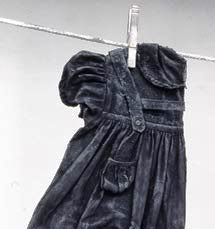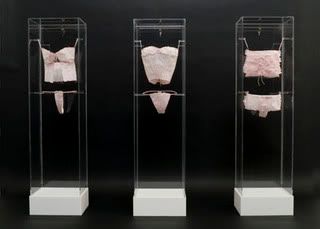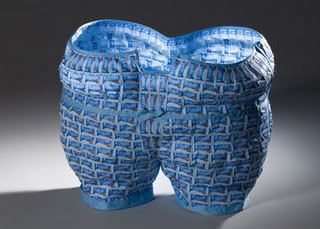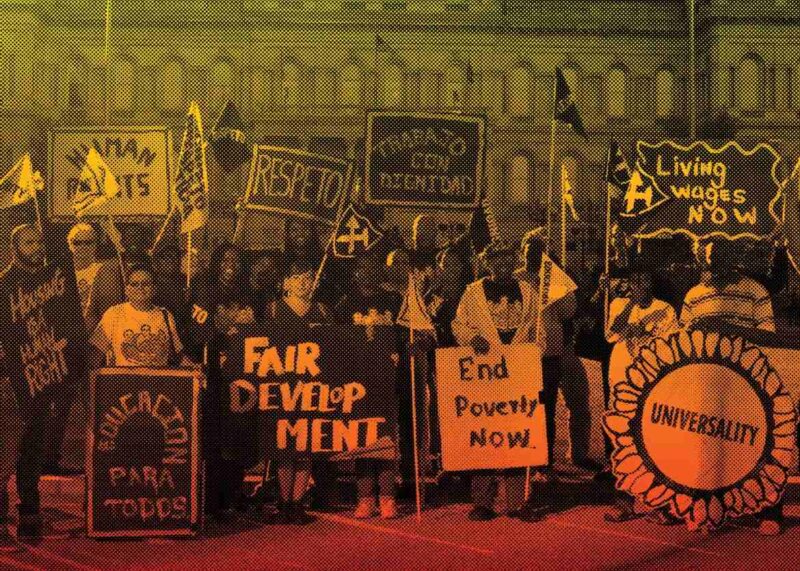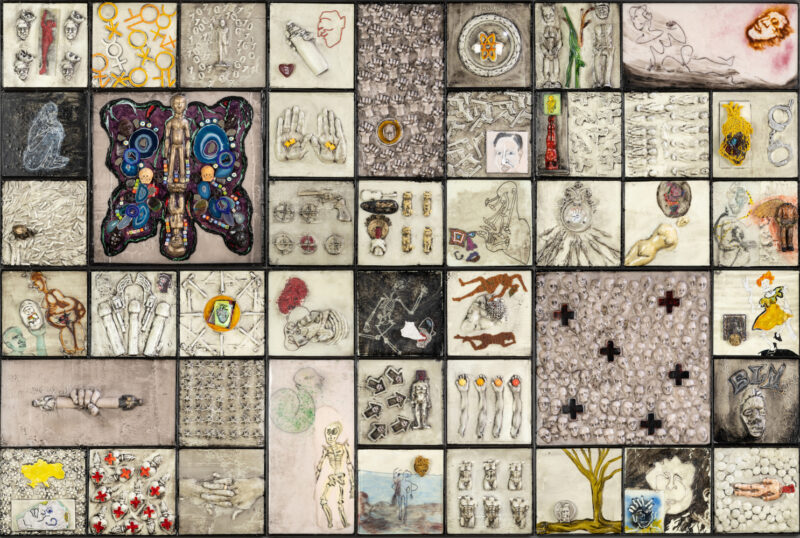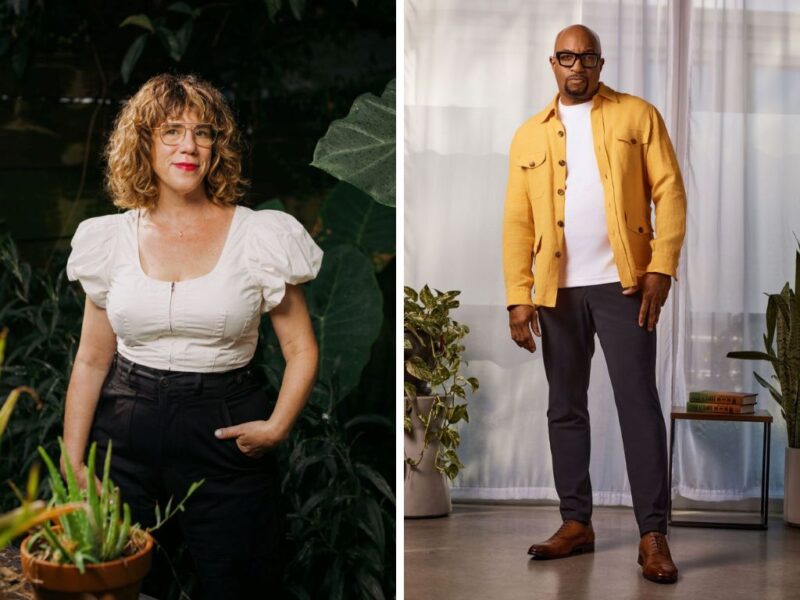Women’s Work, an examination of female identity by artists Char Brooks and Annie Waldrop, will be presented in Goucher College’s Rosenberg Gallery from Friday, August 27 through Friday, October 12. This exhibit, which is free and open to the public, can be viewed weekdays from 9 a.m. to 5 p.m. and during scheduled events in Kraushaar Auditorium.
An artists’ reception will be held Thursday, September 20 at 5 p.m.
Women’s Work: Essay by Cara Ober
“Few tasks are more like the torture of Sisyphus than housework, with its endless repetition: the clean becomes soiled, the soiled is made clean, over and over, day after day” – Simone de Bovior
If the artist’s quest is the search for identity, then it is only logical to express this character in language and terms, which are specific to the artist. Traditionally, ‘women’s work’ has been excluded from the art historical cannon. Called craft instead, needlework, knitting, home décor, and fashion has occupied a secondary role to traditional art media, like paintings and sculpture, for several thousand years. Therefore, it is no surprise that female voices, opinions, and subjects have been excluded from the history of art, with only the occasional exception to the rule, because their means of expression was not considered valid. You only have to take one art history class to discover this.
However, radical change is afoot. Today, there’s a global art movement to reclaim the techniques and materials, once snubbed as craft, at the forefront of the art world. Female subjects like housework, menstruation, marriage, and child-rearing have become acceptable and even popular topics, due in part to the efforts of feminist movements like the Guerrilla Girls and also by the creation of exhibition spaces specifically for women, such as the National Women’s Museum in Washington, DC. Artists like Sophie Calle, Louise Bourgeois, Magdalena Abrakanowicz, and Judy Chicago have successfully blazed a trail for emerging female artists and suddenly, subjects once considered too personal or too mundane are being accepted and recognized by wide audiences.
Char Brooks and Annie Waldrop are both artists who continue in this new tradition. Both examine female identity through personal voices, and both use non-traditional or ‘female’ materials to make their work. With backgrounds in sculpture, ceramics, fashion design, and education, the stage has been set for Waldrop and Brooks to express their highly developed theories on female identity in a vocabulary that is specific to their subject matter.
“One should either be a work of art, or wear a work of art.” – Oscar Wilde
Char Brooks creates clothing to be seen, but not worn. Exploiting the fashion industry, rather than the other way around, Char crafts clothing out of the most unexpected materials. “The Three Graces” consists of three separate sets of sexy lingerie, displayed tantalizingly in glass vitrines, not unlike the window of a Victoria’s Secret store. Each bustier is a little bit different – one has delicate ruffles, another has an S&M lace-up back, another has a peek-a-boo front, and each accompanying thong or panty is equally delicate and unique. From a distance, their pale pink color flirtatiously beckons you in for a closer look. It is then that you can read the ‘carefree’ logo repeated as an all-over pattern and you realize: this lingerie is meticulously sewn from tampon wrappers! The seamless craftsmanship in these works creates the ironic punch: for just a second you believed that the fantasy lingerie model actually existed. However, the tampon wrappers are the taboo reality, which is anything but carefree.
Likewise, in Brook’s series of female torsos, their non-traditional materials contradict their purpose. “Equal Torso” and “Torso 1” appear to be girdles for large women. Stout and imposing, with small lacy touches around the edges, a closer look shows they are made entirely of individual packets of sugar substitutes, stitched together so carefully you can’t see the seams. Irony abounds: NutraSweet and Equal are both marketed to large women as a weight-loss miracle, but both chemicals are potentially cancerous. In her series of “Pill Housecoats,” Brooks plies the homey dress of elderly women against the reality of age and failing health. Their clear plastic shapes do the opposite of what these clothing articles really do – hide an imperfect, aging body, while the red pills dance in polka dotted patterns over their surface, a reminder of the actuality of old age.
In all Brooks’ work, the beauty and believability of the objects is integral to their success – the transformative fantasy of fashion is at once glorified and turned on its ear. Brooks’ craftsmanship is impeccable, as well as her choices in materials for specific purposes and messages. Rather than preaching about the differences between reality and fantasy, Brooks chooses a sly and subtle humor, shrouded in beautiful craft. Insidious and clever, these works first delight visually, and then go for the throat.
Annie Waldrop has a similar penchant for unusual art-making materials and feminist topics. In her sculptures and mixed-media installations, Waldrop explores the dark side female relationships, domesticity, and nostalgia, while using their artifacts as building blocks.
“I am thankful for a lawn that needs mowing, windows that need cleaning and gutters that need fixing because it means I have a home…. I am thankful for the piles of laundry and ironing because it means my loved ones are nearby.” – Nancie J. Carmody
All of Annie Waldrop’s work includes ‘found’ objects, many of which are uncovered at flea markets and thrift stores. Objects like old irons, buttons, clothing, and Victorian portraits take on new meanings and significance in the ways that they are combined. In “Baggage,” an old suitcase is transformed into an interactive narrative by strategically placed mirrors and two Victorian portraits – one of a man, the other of a woman. As the viewer unzips the suitcase, she sees herself in the mirrors, and looks through the eyes of the subjects in the old photos. Alluding to psychological and emotional ‘baggage’ – from family and ancestors – these previously used objects take on a new significance.
In “Swept Away,” Waldrop examines multiple layers of female identity through simple objects. A vintage christening gown lies on a table. On top of the dress, several eggs, wrapped in old text, are arranged. Underneath, an old broom hangs, suspended. Despite the simplicity of each object and the arrangement, “Swept Away” alludes to the impermanence of childhood, the never-ending chores of motherhood, the price of fertility, and also an ‘under the table’ suggestion of witchcraft. The simultaneous complexity and simplicity of Waldrop’s sculptures is their success. By choosing evocative ‘found’ symbols and combining them with others, Waldrop successfully crafts surreal narratives out of ordinary stuff.
Most often, Waldrop uses a stark palette of black, white, and neutral colors, which helps to unite disparate objects. Aesthetically spare and elegant, the eggs, seeds, and white dresses coalesce with bleached and stained artifacts in sepias and browns, and seem to belong together. Likewise, stories of fertility, family, and childhood combine and cross-pollinate one another, seeping out of the objects in quiet whispers of the past. Many of these stories have a bittersweet edge, and a forlorn or neglectful quality, despite their purposeful craftsmanship, and raise questions about the reality of family and aging in today’s world.
After investigating and re-claiming traditionally ‘women’s’ subjects and crafts, both Char Brooks and Annie Waldrop illuminate the reality of womanhood, specifically the inequities and paradox of being a woman, in their work. Despite a stark message, both artists attempt to educate, to enlighten, and to entertain their viewers with the hopeful purpose of making the world a better place. The viewer can’t help but be seduced by these two consummate craftspeople; each of their works has a seamless and believable life of its own.
http://meyerhoff.goucher.edu/rosenberg/
